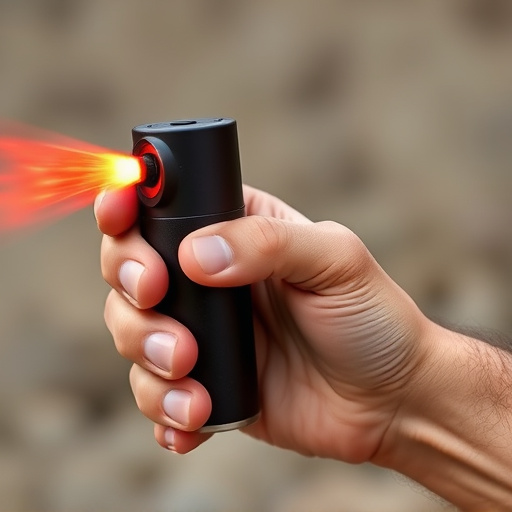Pepper spray is a powerful tool for defending against aggressive dogs, temporarily disabling their vision and respiratory systems. Its modern formulations offer improved effectiveness and ease of use, making it a popular choice for personal safety during walks or outdoor activities with potential dog encounters. To deploy pepper spray successfully, aim for the eyes and face to blind and disorient the attacker, maintaining distance afterward. However, its use is controversial due to legal restrictions and ethical concerns; responsible usage involves proper training, understanding legal frameworks, and considering alternatives, as it can cause significant side effects.
In today’s world, knowing how to defend against potential attackers is crucial. One effective tool that has gained popularity for self-defense against dogs and other threats is pepper spray. This article delves into the intricacies of understanding and utilizing pepper spray as a defense mechanism. We explore its efficacy against dogs, optimal deployment strategies, safety guidelines, and legal considerations surrounding its use. By the end, readers will be equipped with knowledge to make informed decisions about pepper spray defense.
- Understanding Pepper Spray and Its Efficacy Against Dogs
- When and How to Deploy Pepper Spray for Maximum Effectiveness
- Safety Considerations and Best Practices for Using Pepper Spray
- Legal Implications and Ethical Use of Pepper Spray for Self-Defense
Understanding Pepper Spray and Its Efficacy Against Dogs
Pepper spray, a common self-defense tool, has shown significant effectiveness in deterring and neutralizing potential dog attackers. When deployed, it creates an irritant that temporarily disables the canine’s eyes and respiratory system, allowing the user time to escape or de-escalate the situation. This non-lethal method of defense is particularly valuable for individuals who find themselves facing aggressive dogs.
Research indicates that pepper spray can be a game-changer in dog attack scenarios. The active ingredients in modern pepper sprays are designed to maximize their impact on dogs, ensuring a faster response and greater control compared to traditional methods. Its ease of use and high success rate make it an appealing option for personal safety, especially during walks or outdoor activities where dog encounters are possible.
When and How to Deploy Pepper Spray for Maximum Effectiveness
When deploying pepper spray as a defense against attackers, including dogs, timing and technique are crucial for maximum effectiveness. The ideal moment to use pepper spray is during an attack or when you sense an imminent threat. Aim for the eyes and face—these areas are highly sensitive, and the spray can temporarily blind and disorient your assailant. A quick, controlled release of the spray will create a safe opportunity for you to escape or subdue the attacker.
To ensure success, hold the canister at close range (around 3-5 feet) and direct the stream toward the eyes and nose. Use a sweeping motion to cover both sides of the face. After deployment, maintain distance until the attacker shows signs of disorientation or has retreated. Remember, pepper spray is meant to incapacitate temporarily, allowing you time to escape or call for help.
Safety Considerations and Best Practices for Using Pepper Spray
When using pepper spray as a defense against potential attackers, including dogs, safety must always be the top priority. Pepper spray can cause temporary but severe discomfort and respiratory distress in both humans and animals. It’s crucial to understand that aiming at the face or eyes is particularly dangerous and should be avoided unless absolutely necessary for self-defense. Always keep a safe distance, aiming for the legs or torso where the spray will have maximum impact while minimizing harm.
Best practices include ensuring proper training in pepper spray usage before considering it as a defensive tool. Practice with a range or simulation to familiarize yourself with its effects and range. Keep your spray readily accessible, but store it securely out of reach of children and pets. Regularly check the expiration date, as pepper spray can lose its effectiveness over time. Additionally, be mindful of environmental factors; wind direction and humidity can affect how the spray disperses, so choose a location where you have control over these conditions if possible.
Legal Implications and Ethical Use of Pepper Spray for Self-Defense
The use of pepper spray as a self-defense mechanism against dogs, or any attacker, is a controversial topic with significant legal and ethical implications. While it can provide individuals with an effective means to deter and incapacitate a potential threat, its application must adhere to strict guidelines. Many jurisdictions have specific laws governing the possession and use of pepper spray, particularly for civilian use. These laws often require proper training, certification, and licensing to ensure safe and legal deployment.
The ethical considerations surrounding pepper spray defense are equally important. The use of force, including chemical agents like pepper spray, must be a last resort when all other means of escaping or de-escalating a situation have been exhausted. It should not be employed in a reckless manner, as it can cause temporary disorientation, breathing difficulties, and even more severe health issues for the target, especially those with pre-existing conditions. Responsible use requires individuals to assess the level of danger and consider alternative options before resorting to pepper spray defense against dogs or any other attackers.
Pepper spray has established itself as a powerful tool for self-defense against dogs, offering a safe and effective means to deter aggressive encounters. By understanding its efficacy, proper deployment techniques, and legal boundaries, individuals can make informed decisions to protect themselves and their loved ones. When used responsibly, pepper spray defense against dogs can be a game-changer in navigating potentially dangerous situations, ensuring safety while adhering to ethical guidelines.
